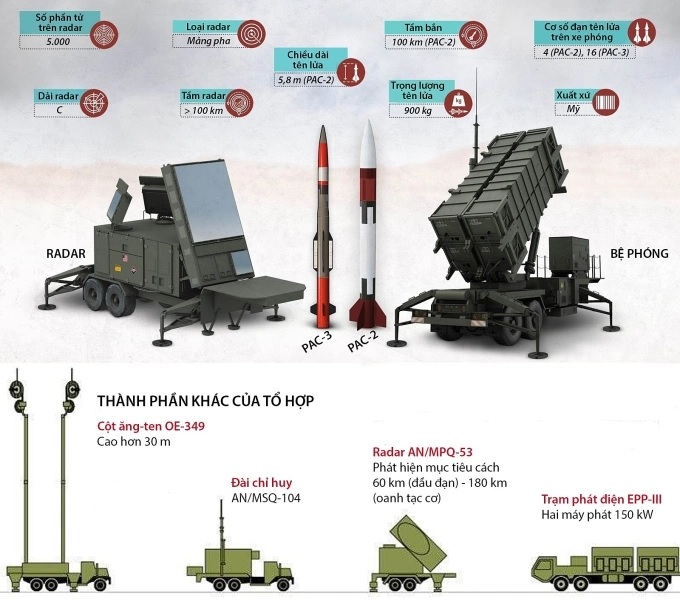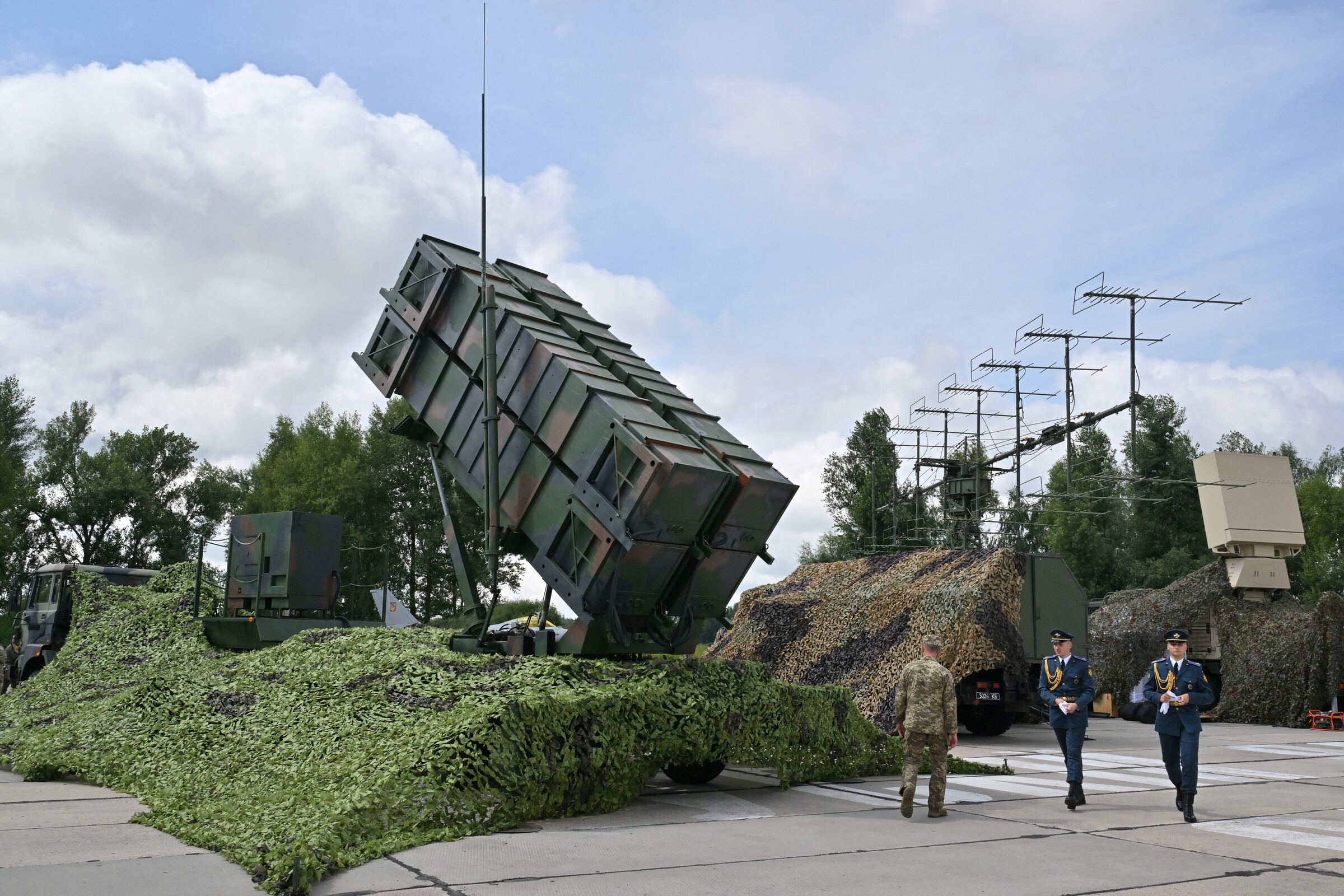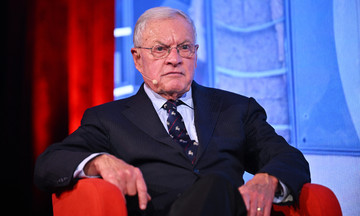During a meeting with NATO Secretary General Mark Rutte at the White House on 14/7, US President Donald Trump announced Washington's collaboration with allies to immediately supply Ukraine with "17 Patriots," an air defense system he deemed crucial for Kyiv's needs.
Earlier this month, German government spokesperson Stefan Kornelius revealed "various methods" were being considered to provide Patriot missiles to Ukraine, including European nations purchasing the systems from Washington for subsequent transfer to Kyiv.
The Patriot system is a sought-after defense asset for Ukraine, considered the only weapon in its arsenal capable of countering Russian ballistic and hypersonic missiles.
Each Patriot launcher can fire 32 missiles in seconds. The warheads travel at extreme velocity, impacting targets with a bright flash and powerful shockwave.
 |
Components of the Patriot system. Click image for details. (Source not provided) |
Components of the Patriot system. Click image for details. (Source not provided)
Ukraine initially received Patriots from the US and Western European allies in April 2023. Within weeks, they intercepted Russian Kinzhal hypersonic missiles launched from fighter jets at altitudes exceeding 12 km.
President Trump's decision to sell Patriot systems to European allies for transfer to Ukraine is significant for Kyiv, providing momentum in its conflict with Russia. This marks the first time the Trump White House has agreed to such arms provisions.
However, observers find Trump's announcement unclear, potentially confusing Ukraine and European nations. The president didn't specify whether "17 Patriots" referred to complete systems or individual launchers. A full Patriot system comprises 4-8 launchers, radar, and control systems.
"If he meant 17 complete systems, that would be a very large number. 17 individual launchers seems more feasible," said Major General Vadym Skibitskyi, deputy director of Ukraine's military intelligence agency (GUR).
Even with 17 complete Patriot systems, Ukraine would struggle against Russia's recent "firestorms" of hundreds of suicide drones and missiles, according to military experts.
Quantitatively, this aid level may not meet Ukraine's air defense needs. The country estimates it requires 25 more Patriot systems to protect key urban areas, according to Lieutenant General Ihor Romanenko, former deputy chief of the military's general staff.
The mid-summer announcement of Patriot aid is considered belated, as Ukraine braces for a harsh winter. Continued attacks on energy infrastructure and critical facilities could mean another cold, dark season for Ukrainians.
Ukrainian firefighters extinguish flames after a Russian attack on the morning of 16/7. Video: X/ZelenskyyUa. (Source: X/ZelenskyyUa)
German Chancellor Friedrich Merz, in a post on X on 14/7, assured President Trump that Germany would play a "decisive role" in providing Patriot missiles to Ukraine. Trump suggested Germany would send missiles "soon" and "they will be replaced," but provided no specifics.
Key questions remain: when will these systems reach Ukraine, and what will the actual quantity be? Analysts suggest the Patriots' effectiveness depends on rapid delivery and subsequent resupply of missiles.
"Russia's tactic is to deplete Ukraine's air defenses, leaving them vulnerable to attacks in late summer or autumn. To alter Putin's calculations, substantial Patriot deliveries must be sustained throughout the summer," said Celeste Wallander, a former senior Pentagon official under the Joe Biden administration.
Kristine Berzina of the German Marshall Fund suggests European countries could send their existing Patriots to Ukraine, then replenish their stocks with new US supplies. "But if Germany and others wait for new US Patriots before transferring them to Ukraine, the help may come too late," Berzina said.
The US and its allies face limitations in providing air defense to Ukraine, not only due to cost but also Western production capacity.
Lockheed Martin produced 500 PAC-3 interceptor missiles for the Patriot system last year and plans to increase output to 650 by 2027.
One option to meet Ukraine's Patriot needs is direct purchase from Lockheed Martin. However, high global demand means new customers could face years-long waits.
President Trump could expedite the process by prioritizing delivery to Ukraine, but this might delay shipments to other US allies.
 |
Patriot air defense system at an undisclosed location in Ukraine, August 2024. Photo: AFP. (Source: AFP) |
Patriot air defense system at an undisclosed location in Ukraine, August 2024. Photo: AFP. (Source: AFP)
Analysts in Kyiv believe new Patriots could be deployed in major cities, mitigating damage from Russian missiles. However, they see this as insufficient.
"The issue isn't just Patriots. We need more than Patriots to intercept ballistic missiles. Russia's main air attack weapon is now the drone. They're causing most of the damage," said Volodymyr Fesenko, head of the Penta Center think tank.
Russian drones now fly in swarms of hundreds. Ukraine primarily counters them with mobile anti-aircraft gun units. This tactic is becoming less effective as Russia deploys new jet-powered drones that fly at 5 km altitude and speeds up to 500 km/h, rendering machine gun fire useless.
Ukraine needs interceptor drones with comparable speed and altitude. "Quantity is the issue. If they launch 700-1,000 drones per attack, we need hundreds of interceptor drones," Romanenko said.
 |
Russian attacks with drones (yellow) and cruise missiles (red) targeting Ukraine on the morning of 12/7. Image: X/clashreport. (Source: X/clashreport) |
Russian attacks with drones (yellow) and cruise missiles (red) targeting Ukraine on the morning of 12/7. Image: X/clashreport. (Source: X/clashreport)
Russia constantly adapts its drone flight paths to evade interception, so Ukraine requires light aircraft, electronic jamming equipment, helicopters, and air defense systems to counter them.
Ukraine's Ministry of Defense has been slow to develop effective interceptor drones. "Everything is at an amateur level," said Andrey Pronin, who runs a drone pilot school in Kyiv.
Pronin claims involvement in developing drones capable of intercepting Russian suicide drones. Despite proven combat effectiveness, the Ministry of Defense has shown little interest in further development. "The Ministry of Defense hasn't invested in the project at all," he said.
Thuy Lam (Al Jazeera, WSJ)












